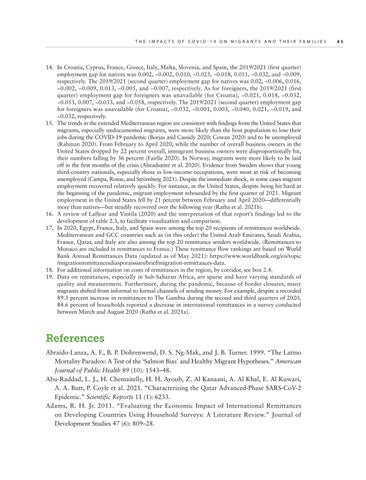Th e I m pac t s o f C OVID - 1 9 o n M i g r a n t s a n d Th e i r F a m i l i e s
14. In Croatia, Cyprus, France, Greece, Italy, Malta, Slovenia, and Spain, the 2019/2021 (first quarter) employment gap for natives was 0.002, −0.002, 0.010, −0.023, −0.018, 0.011, −0.032, and −0.009, respectively. The 2019/2021 (second quarter) employment gap for natives was 0.02, −0.006, 0.016, −0.002, −0.009, 0.013, −0.005, and −0.007, respectively. As for foreigners, the 2019/2021 (first quarter) employment gap for foreigners was unavailable (for Croatia), −0.021, 0.018, −0.032, −0.053, 0.007, −0.033, and −0.058, respectively. The 2019/2021 (second quarter) employment gap for foreigners was unavailable (for Croatia), −0.032, −0.001, 0.003, −0.040, 0.021, −0.019, and −0.032, respectively. 15. The trends in the extended Mediterranean region are consistent with findings from the United States that migrants, especially undocumented migrants, were more likely than the host population to lose their jobs during the COVID-19 pandemic (Borjas and Cassidy 2020; Cowan 2020) and to be unemployed (Rahman 2020). From February to April 2020, while the number of overall business owners in the United States dropped by 22 percent overall, immigrant business owners were disproportionally hit, their numbers falling by 36 percent (Fairlie 2020). In Norway, migrants were more likely to be laid off in the first months of the crisis (Alstadsæter et al. 2020). Evidence from Sweden shows that young third-country nationals, especially those in low-income occupations, were most at risk of becoming unemployed (Campa, Roine, and Strömberg 2021). Despite the immediate shock, in some cases migrant employment recovered relatively quickly. For instance, in the United States, despite being hit hard at the beginning of the pandemic, migrant employment rebounded by the first quarter of 2021. Migrant employment in the United States fell by 21 percent between February and April 2020—differentially more than natives—but steadily recovered over the following year (Ratha et al. 2021b). 16. A review of Lafleur and Vintila (2020) and the interpretation of that report’s findings led to the development of table 2.3, to facilitate visualization and comparison. 17. In 2020, Egypt, France, Italy, and Spain were among the top 20 recipients of remittances worldwide. Mediterranean and GCC countries such as (in this order) the United Arab Emirates, Saudi Arabia, France, Qatar, and Italy are also among the top 20 remittance senders worldwide. (Remittances to Monaco are included in remittances to France.) These remittance flow rankings are based on World Bank Annual Remittances Data (updated as of May 2021): https://www.worldbank.org/en/topic /migrationremittancesdiasporaissues/brief/migration-remittances-data. 18. For additional information on costs of remittances in the region, by corridor, see box 2.4. 19. Data on remittances, especially in Sub-Saharan Africa, are sparse and have varying standards of quality and measurement. Furthermore, during the pandemic, because of border closures, many migrants shifted from informal to formal channels of sending money. For example, despite a recorded 89.3 percent increase in remittances to The Gambia during the second and third quarters of 2020, 84.6 percent of households reported a decrease in international remittances in a survey conducted between March and August 2020 (Ratha et al. 2021a).
References Abraído-Lanza, A. F., B. P. Dohrenwend, D. S. Ng-Mak, and J. B. Turner. 1999. “The Latino Mortality Paradox: A Test of the ‘Salmon Bias’ and Healthy Migrant Hypotheses.” American Journal of Public Health 89 (10): 1543–48. Abu-Raddad, L. J., H. Chemaitelly, H. H. Ayoub, Z. Al Kanaani, A. Al Khal, E. Al Kuwari, A. A. Butt, P. Coyle et al. 2021. “Characterizing the Qatar Advanced-Phase SARS-CoV-2 Epidemic.” Scientific Reports 11 (1): 6233. Adams, R. H. Jr. 2011. “Evaluating the Economic Impact of International Remittances on Developing Countries Using Household Surveys: A Literature Review.” Journal of Development Studies 47 (6): 809–28.
8 5

